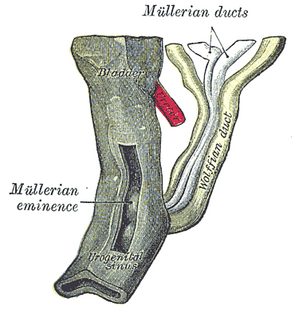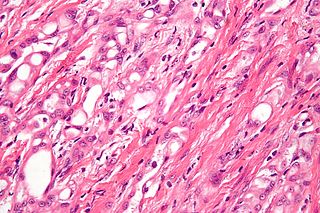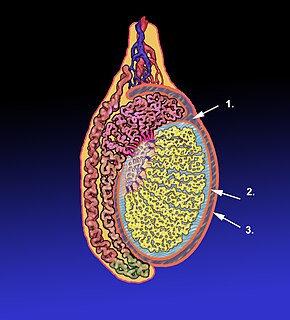This page is based on this
Wikipedia article Text is available under the
CC BY-SA 4.0 license; additional terms may apply.
Images, videos and audio are available under their respective licenses.

The vas deferens, also called ductus deferens, is part of the male reproductive system of many vertebrates; these ducts transport sperm from the epididymis to the ejaculatory ducts in anticipation of ejaculation. It is a partially coiled tube which exits the abdominal cavity through the inguinal canal.

The mesonephric duct is a paired organ found in mammals including humans during embryogenesis. Wolffian structures are male urogenital structures that include the epididymis, vas deferens, and seminal vesicles that differentiate from this structure.

Epididymitis is a medical condition characterized by inflammation of the epididymis, a curved structure at the back of the testicle. Onset of pain is typically over a day or two. The pain may improve with raising the testicle. Other symptoms may include swelling of the testicle, burning with urination, or frequent urination. Inflammation of the testicle is commonly also present.

Spermatocele is a retention cyst of a tubule of the rete testis or the head of the epididymis distended with barely watery fluid that contains spermatozoa. Small spermatoceles are relatively common, occurring in an estimated 30 percent of all men. They vary in size from several millimeters to many centimeters. Spermatoceles are generally not painful. However, some men may experience discomfort from larger spermatoceles. They are not cancerous, nor do they cause an increased risk of testicular cancer. Additionally, unlike varicoceles, they do not reduce fertility.

Polyorchidism is the incidence of more than two testicles. It is a very rare congenital disorder, with fewer than 201 cases reported in medical literature and 6 cases in veterinary literature.

The efferent ducts connect the rete testis with the initial section of the epididymis.

The appendix of the epididymis is a small stalked appendage on the head of the epididymis. It is usually regarded as a detached efferent duct.

A pseudostratified epithelium is a type of epithelium that, though comprising only a single layer of cells, has its cell nuclei positioned in a manner suggestive of stratified epithelia. As it
rarely occurs as squamous or cuboidal epithelia, it is usually considered synonymous with the term pseudostratified columnar epithelium.
The term paradidymis is applied to a small collection of convoluted tubules, situated in front of the lower part of the spermatic cord, above the head of the epididymis.

Stereocilia are non-motile apical modifications of the cell, which are distinct from cilia and microvilli, but closely related to the latter.
The Inferior ligament of the epididymis is a strand of fibrous tissue which is covered by a reflection of the tunica vaginalis and connects the lower aspect of the epididymis with the testis.
A spermatocelectomy is a surgical procedure performed to remove a spermatocele by separating it from the epididymis. The patient is given an anesthetic in the groin and a small incision is made into the scrotum. The surgeon pulls the testicle and epididymis to the incision and separates the spermatocele by tying it off with a suture. The surgeon then removes it, and stitches up the area.

Adenomatoid tumor is a benign mesothelial tumor, which arises from the lining of organs. It generally presents in the genital tract, in regions such as the testis and epididymis. It is the second most common extratesticular scrotal mass, after lipoma, and accounts for 30% of these masses. It also has been found in the pancreas.
The seminal tract is a part of the male reproductive system and consists of Seminiferous tubules, Epididymis (Appendix), Vas deferens (Ampulla) and Ejaculatory duct.
Vasoepididymostomy or epididymovasostomy is a surgery by which vasectomies are reversed. It involves connection of the severed vas deferens to the epididymis and is more technically demanding than the vasovasostomy.

Disintegrin and metalloproteinase domain-containing protein 7 is a protein that in humans is encoded by the ADAM7 gene. ADAM7 is an 85-kDa enzyme that is a member of the transmembrane ADAM protein family. Members of this family are membrane-anchored proteins structurally related to snake venom disintegrins, and have been implicated in a variety of biological processes involving cell-cell and cell-matrix interactions, including fertilization, muscle development, and neurogenesis. ADAM7 is important for the maturation of sperm cells in mammals. ADAM7 is also denoted as: ADAM_7, ADAM-7, EAPI, GP-83, and GP83.

Scrotal ultrasound is a medical ultrasound examination of the scrotum. It is used in the evaluation of testicular pain, and can help identify solid masses.
Ligament of epididymis may refer to:













